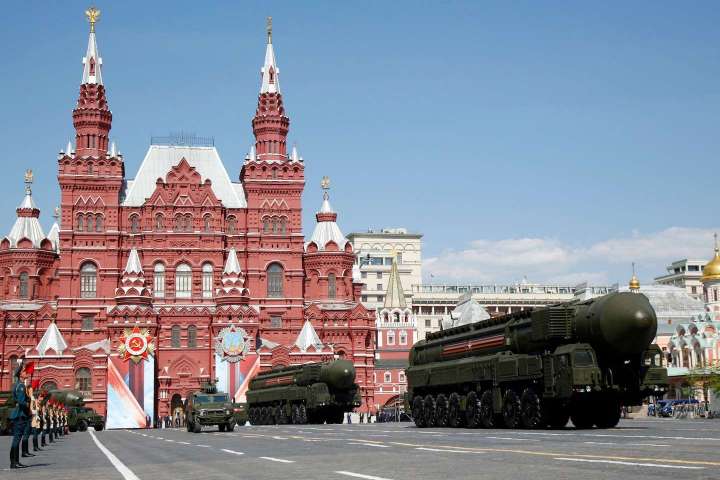Joseph Cirincione is author of “Nuclear Nightmares: Securing the World Before It Is Too Late.”
Putin says nuclear threat is no bluff. Here are some scenarios.

It is difficult to put percentages on risk. Nor does it really matter. Given the stakes, if the chances are 10 percent or 40 percent, the response would be the same: Minimize the possibility of nuclear use, and prepare responses in advance.
That is what U.S. military and intelligence leaders are doing — and have been doing since the early days of the war. They are studying all the possible use scenarios. U.S. intelligence is closely watching for any sign that a nuclear weapon is being readied.
We should believe Putin that “this is not a bluff.” The first use of nuclear weapons in a conflict is an integral part of Russian military doctrine, as it is in U.S. war plans. Unlike the United States, Russia regularly practices for the use of nuclear weapons and integrates them into its conventional military exercises, most recently just before Putin‘s invasion.
Russian military writings describe in detail how, if Russia is losing a conflict, it could use nuclear weapons to force its enemy to retreat. This “escalate to de-escalate” or “escalate to win” strategy is somewhat controversial, but it is not dissimilar to various U.S. plans for using nuclear weapons first.
What would that look like in Ukraine? There are numerous scenarios, with scores of variations, but they fall into a small number of broad scenarios.
Demonstration shot. One option is for Russia to fire a nuclear weapon over an uninhabited area — say, part of the Black Sea — as a demonstration of its seriousness in hopes that the West will back down. Some scientists involved in the Manhattan Project urged just such a demonstration shot as an alternative to bombing Japanese cities at the end of World War II. While no one would be killed and there would not be physical damage, the explosion would stop the world in its tracks. There has not been a nuclear weapon used in combat in 77 years. No one has even seen a nuclear explosion above ground since 1980.
This explosion would not require a nuclear response by the United States. To prevent further escalation, President Biden could call for Russia’s international isolation (China and India, for example, would quickly distance themselves), impose extraordinarily harsh new sanctions and issue warnings of grave consequences should Russia proceed with additional explosions.
As shocking as this would be, Russia would likely reject this option for the same reason U.S. military leaders did in 1945: It is not shocking enough.
Low-yield weapon. Russia could fire a “low-yield” nuclear weapon on a Ukrainian military target. The explosion would kill hundreds or thousands and cause significant damage. Russia could use one of the 10-kiloton warheads it deploys on some of its ground-launched cruise missiles, including the Iskander that has been used extensively in the war with conventional warheads. Although this would be a massive explosion — equal to 10,000 tons of TNT — it would be small by nuclear standards. The bomb that destroyed Hiroshima was 15 kilotons; most U.S. and Russian nuclear warheads range from 100 to 1,000 kilotons. Some believe that Russia has even smaller-yield warheads, in the one-kiloton range.
This might be the most likely scenario. Again, it would not require a “response in kind” by the United States, though some would urge that. The likely response, in addition to those in scenario one, would be massive increases in military aid to Ukraine and possibly concerted NATO or U.S. strikes on the Russian units that launched the attack.
Large-yield weapon. Putin could dial up the explosive force of the attack to the 50- or 100-kiloton range, or about three to six times the Hiroshima bomb. Tens of thousands would die with massive damage and radiation plumes. If the target were Kyiv, it would decapitate Ukraine’s leadership. This would almost certainly trigger a direct U.S. or NATO response, though not likely nuclear. The United States and NATO have sufficient precise, powerful conventional weapons that they could use to devastate Russian forces in Ukraine and command headquarters, including those units responsible for the attack. This would likely be accompanied by large-scale cyber operations.
Nuclear attack on NATO. This is the least likely scenario. Russian first-use doctrine includes the option of striking NATO targets. The attack could be by long-range missiles or air-launched cruise missiles on Central European states. If the yield of the weapon was similar to the previous scenario, it would inflict a level of destruction on a NATO state not seen since World War II. This could trigger a nuclear response. Some would argue a limited nuclear counterstrike was necessary to preserve nuclear deterrence. More likely is an all-out conventional assault to try to eliminate either Putin himself or the weapons he commands before he strikes again.
These are horrible scenarios to consider. If you are worried, you are having the appropriate reaction. We should do all we can now to prepare a massive political response that might deter Putin from crossing the nuclear line.






